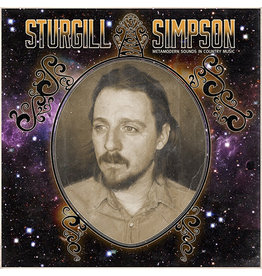Simpson, Sturgill: A Sailor's Guide to Earth LP
| Availability: | Out of stock |
Sturgill Simpson's A Sailor's Guide to Earth is the rare album that traverses the entire world, both musically and lyrically. It's dizzyingly diverse, jumping from one style to the next, with ports of call in Motor City and Music Row, Harlem and Stax, Berlin and London, yet it never leaves Simpson's very specific point of view. It's his most personal album as well as his most ambitious: a song cycle penned as a sailor's poignant letter home to the wife and child he left behind.
Aptly, A Sailor's Guide to Earth is all over the map, presenting Simpson as music's most daring auteur. He combines the sophisticated soul of '70s Motown, the stomping R&B flash of the Dap-Kings, the reckless rave-ups of the Stones and the Clash, even the countrypolitan flare of legendary Nashville producer Owen Bradley. "I wanted it to be an exploration of all the different types of music that I love – a musical journey," he says. "I listen to a lot of Marvin Gaye, a lot of Bill Withers. I like the way George Harrison sings and tried to incorporate that. Some people will say I'm trying to run from country, but I'm never going to make anything other than a country record. As soon as I open my mouth, it's going to be a country song."
For Simpson, who produced the album himself, country music is a strong foundation for heady experimentation and exploration. He's been leading the charge to expand the genre's reach, opening the doors for a new generation of rule-breaking musicians. His 2013 debut, High Top Mountain, introduced him as a bold and raucous innovator with a sharp burr of a voice and a rousing band behind him. He followed it up quickly with 2014's Metamodern Sounds in Country Music, a headtrip album full of backmasked guitars, psychedelic Mellotron strings and heartfelt musings on the universe and his place within it. The album proved a surprise international hit, placing high on year-end lists across the board.
"I knew I wanted to make a concept record in song-cycle form, like my favorite Marvin Gaye records where everything just continuously flows," he explains about its follow-up. "I also wanted it to be something that when my son is older and maybe I'm gone, he can listen to it and get a sense of who I was. I just wanted to talk as directly to him as possible." He does just that on opener "Welcome To Earth (Pollywog)," which kicks the album off with a tense drone intro that relents to a Bowie-by-way-of-Bradley piano theme. A few measures later, the song explodes into a stomping R&B coda that showcases his soulful vocals and the down-and-dirty flash of the Dap-Kings horn section. Side one ends with a cover of Nirvana's "In Bloom," rendered completely unrecognizable by a swirl of strings and horns.
The world Simpson depicts for his son on the quiet lullaby "Breaker's Roar" and the blazing rocker "Brace for Impact (Live a Little)" is immense and full of boundless possibility. Yet he realizes "the world's getting really scary – scarier than it's been in a long time. And I'm scared for him. What is the world going to be like twenty years from now?" That concern pervades A Sailor's Guide to Earth, especially the final song. "Call to Arms" surveys the evils of the world: terrorism, missile tests, oil wars, racism, all the bullshit that breeds on the nightly news. With its breakneck pace, the song sounds like an exorcism, evoking the worry that all parents feel about how the world will treat their children.
On A Sailor's Guide to Earth, Simpson comes across as a man torn between the lure of the road and the security of home, between his love of family and his responsibilities to them, to himself, to his art.




